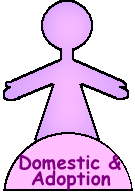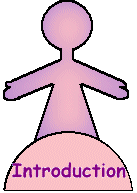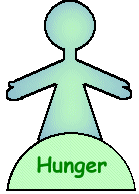
|
"Perhaps the greatest
social service that can be rendered by anybody to the country and to
mankind is to bring up a family." |

|
"Perhaps the greatest
social service that can be rendered by anybody to the country and to
mankind is to bring up a family." |
| <picture of Kate's family> |
On a rainy Sunday morning, three families waited hesitantly at the gates
for the arrival of a plane. They were there to meet their daughters, who
were flying in from a small airport in India. What was special about these
unions was that the families only knew their daughters from a small
passport-sized black-and-white glossy photo. But that morning, when the
two year old girls were carried off the plane, their mothers wasted no
time at all before embracing them in warm, tight hugs. And I, an only
child up to that point, spent a long drive home in the backseat with my
new sister. She spent the drive picking grains of salt off saltine
crackers and eating them one by one. She spent the next week singing
herself to sleep in her crib in Hindi. She spent hours eating food
protectively and pointing out the window, confused. She spent nights in
the bathtub being de-liced and introduced to bath toys. And she spent the
next several months in the hospital with a bout of Malaria. There, she was
given life-saving treatment, as much ice cream as she could eat, and
allowed to sleep with her prized “dues”(shoes) on. A few months after
that, she was back in the hospital with a rare second strain of Malaria.
This year, she started high school, is taking honors courses, and is a
varsity gymnast. Had she remained in India for more than two months, her
disease would have developed, untreated, and killed her before she reached
age three. ~Kate McDevitt |
|
Introduction: Children make an interesting and unique topic to study, because there are organizations in the world not only to aid and protect them, but also to relocate them to better conditions. Unfortunately, not so many children are so lucky as my sister. Children face many dangers in the third world, from warfare to starvation, from child labor to disease-ridden water. The one threat that is shared by children all around the world, both in the developed world and the third world is that of domestic abuse. A child’s domestic life is formed before he or she is even born, and can directly affect the child from the moment of birth. The domestic environment includes the physical lifestyle, the parental and family views of the child, and the parental and family treatment of the child. There are a wide variety of problems associated with each in the third world countries, but also a number of programs and organizations who identify and deal with these issues.
Problems- Deaths at Birth: Problems can strike children from the moment of conception and before they are born due to environmental factors and cultural situations. Infant mortality rates (IMR) are decreasing worldwide on average, as are the rates in the developing world but the decrease is too gradual to save so many. According to the UNICEF statistics shown in the graph here, an average of 63 out of 1000 live births die each year in developing countries. In the least developed countries of the world, it is 102 of 1000, a significant difference from the industrial world’s average of 6. Deaths at birth are many times due to poor health and nutrition of mothers, but in addition a significant number are aborted or murdered at birth. Sometimes the cause is simple unwanted or unsupportable children in cases where birth control has not been used or has failed. But many times the cause is an unwanted baby. If a child is born significantly small, deformed, or terribly weak, some parents prefer to kill it immediately rather than spend resources to feed a child which will suffer and probably die soon anyway. In regions where families much work to survive, another pair of hands is critical for working the land or working in shops.
Domestic & Adoption Frontpage
Top of this page Solutions- Family Planning & Infanticide Prevention:
The problem of infanticide and gerndercide is enormous, and though there have been a few strides taken, the problem is still present. The government in India attempted several activities, such as the Girl Child Protection Scheme, but ability to carry it out and enforce it have failed. This is where NGO’s have stepped in to help. For example, Association and Liberation of Vagaris and Other Minorities (ALVOM), one Swedish NGO which works with domestic NGO’s in India to prevent infanticide. In India, a number of organizations have helped in areas such as reporting cases to the police, counseling expected mothers and involving social workers, offering monetary incentives to families, providing childcare support, and raising awareness in general in many different ways. In the realm of promoting awareness, websites such as http://www.infanticide.org, http://www.gendercide.org/, and http://elandee.com/asia/ promote awareness for the internet-able. By educating more about the events of the world, more organizations and individuals can step up to provide assistance. In China, the solutions are few and currently focusing on public education, counseling, and voluntary participation and compliance to reduce unplanned pregnancies and unwanted births. There is also talk of enforcing the laws against illegal pre-birth gender identification tests. The International Network for the Rights of Female Victims of Violence in Pakistan is also addressing the problem of deaths of female children by organizing small efforts and promoting awareness through study and education. |
| <picture of Andal Damodaran and other Award Finalists> | Mrs. Andal
Damodaran of Chennai, Tamil Nadu, India "Andal Damodaran is one of India's greatest advocates for children's rights. Recipient of the Indian government's National Child Welfare Award in 1985, Damodaran has dedicated the past 28 years of her life to preventing both female infanticide and the exploitation of children through child labor. In addition, her work has focused on providing protection and schooling for child beggars and training for India's childcare workers. Damodaran is the honorary general secretary of the Indian Council for Child Welfare in Tamil Nadu. Her accomplishments through the Council since 1973 include: Prevention of Female Infanticide: Damodaran helped reduce the number of recorded female infanticides in the Southern district of Tamil Nadu from 200 in 1991 to just seven in 2001. This was achieved through the Programme for Prevention of Female Infanticide, created in 1987, which covers 309 hamlets where female infanticide was most prevalent. The program offers monitoring and counseling to pregnant women, post- and pre-natal health care, self-help groups for women, counseling to encourage attitudinal changes toward the female child, educational and vocational training support for female children, and image-building training for adolescent girls. Today, the empowered women's groups in 289 hamlets have taken up monitoring and preventing female infanticide. Likewise, the adolescent girls have formed groups and taken an oath against committing this crime. [as well as:] Eradication and Prevention of Child Labor and Exploitation, Schooling for Child Beggars, Protection for Street Children, Childcare and Training, and Organizational Involvement and Leadership. Damodaran was born Dec. 15, 1940, in Chennai (Madras) India." ~2001 Kellogg’s Hannah Neil World of Children Award Finalists (12) |
Resources used for the domestic life and adoption section (Page 1):






